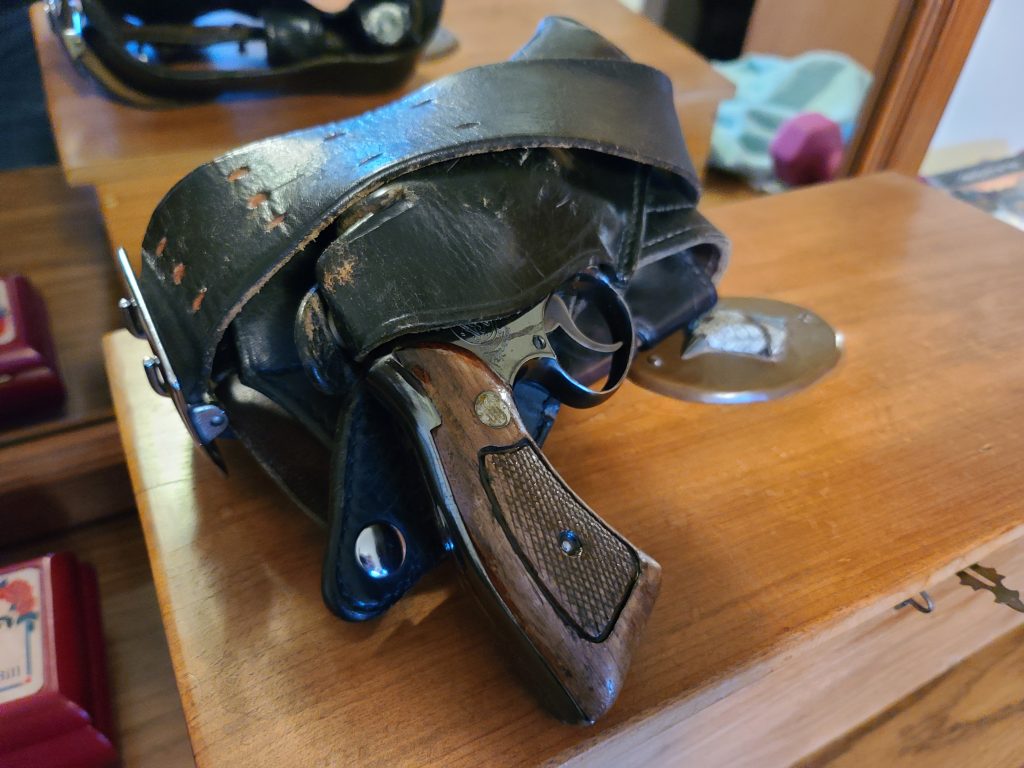This week, I wanted to take a look at a story that symbolizes much of what’s wrong with gun reporting at major media outlets.
The New York Times recently wrote a bit of a hit piece on the acting director of the ATF. It includes comments from prominent figures involved in the story and even some news from White House sources. But it falls flat on its face when describing the guns, laws, and even politics involved.
I pick it apart bit by bit to explain why the lack of knowledge on gun politics and policy is so detrimental to reporting at major outlets.
Contributing Writer Jake Fogleman takes a look at how we made it to the point where now permitless gun-carry is the most common policy in the country. It wasn’t a given this is how things would turn out. But the momentum built up over the past five years is likely to carry the policy even further before all is said and done.
Plus, Jake and I answer your questions on our first Q&A edition of the podcast!

Analysis: The Odd New York Times Attack on the Acting ATF Director [Member Exclusive]
By Stephen Gutowski
The current director of the ATF is too favorable towards the gun industry.
At least, that’s what The New York Times seems to think. In a recent story by reporter Glenn Thrush, acting director Marvin Richardson is painted as at odds with President Joe Biden’s agenda. Thrush described him as “an industry-friendly subordinate pumping the brakes” on the President’s aggressive gun-control message.
So, what makes Richardson so friendly towards the industry he regulates? Well, he went to the industry’s trade show. And he announced new rules restricting guns with pistol braces and expanding the ATF’s power to determine what constitutes a firearm would be finalized by this summer.
These are odd complaints.
For one, the ATF has been attending the industry trade show for decades. The National Shooting Sports Foundation (NSSF), the industry’s trade group, gives them and several other federal agencies booths on the convention floor. Officials often speak at informational events as well.
As I’ve witnessed firsthand at numerous shows, this point is to help gun dealers stay in compliance with federal law. The ATF fields questions from the businesses they regulate and passes on updates about potential coming changes to regulations. Thrush dings Richardson for the second part of that function in particular.
He claims Richardson is slow-walking President Biden’s rule expanding the ATF’s power to determine what a firearm is under federal law. During his event at the trade show, Richardson said the regulation, which the President hopes to use to target “ghost guns,” is due to be finalized by June. Thrush claims it was “expected to have already been in place.”
But that doesn’t match the timeline previous rulemaking on firearms has gone through. The bump stock ban took over a year to be implemented through federal rulemaking. The “ghost gun” rule change is on pace for a similar timeline despite the overwhelmingly negative public comments it received. Thrush presents the fact that the rule hasn’t already been finalized and implemented as some sort of win for the gun industry.
This, too, is odd.
The gun industry gains basically nothing from having the “ghost gun” or pistol brace rules delayed a couple of months. They don’t want them implemented at all. That’s why they helped organize the commenting campaign.
The politics are pretty far off from reality.
The piece goes sideways on the basics of guns and gun law as well. The way it describes gun policies borders on gibberish. The utter lack of understanding by everyone involved in the piece for how guns and gun laws work is on full display.
It talks about the fight over “restrictions on military-style firearms.” Of course, “military-style firearms” is a vague term that I’m guessing is meant to apply to AR-15s or AK-47s, but which could easily apply to nearly any gun that’s ever been employed in some way by a military. Since militaries have used pretty much every kind of gun (from fully-automatic to semi-automatic to bolt-action and pump-action) ever invented, it could apply to almost literally anything.
The piece then asserts “red flag laws” are meant to “keep mentally ill people from carrying guns.” But that isn’t what red flag laws do. Instead of keeping those subject to red flag orders from carrying guns, it temporarily confiscates their firearms altogether.
It also talks about proposals for “enhancing background checks.” But the universal background check proposals, which have been at the center of the gun debate for literally decades, are not about “enhancing” background checks. Instead, they are focused on expanding checks to used gun sales on the private market or, as is the case with the proposal the House passed last year, to any time somebody transfers a gun to somebody else with few exceptions.
But that’s just what was left in the piece. The Times actually edited out the worst bit without a correction. It described Biden’s proposed rule to effectively ban and register guns equipped with pistol braces as “a rule banning the use of high-capacity ‘bump stocks.'”
Of course, bump stocks are… stocks. They aren’t ammunition magazines. They don’t have a capacity.
That is an embarrassing word salad of buzzy gun terms. It is pretty amazing The Times didn’t even attempt to fix the description of the rule and instead stealth edited it away. It seems they figured out it was wrong but couldn’t figure out an accurate way to describe it.
There are also several reasons to think President Biden’s failed ATF Director nominee David Chipman was relied on for much of the narrative in the piece. Chipman’s first interview after bowing out of consideration was with Thrush, who treated him with a very light touch in stark contrast to how he’s treating Richardson. In this piece, as in the interview, Thrush pins Chipman’s downfall on the spread of a picture falsely said to have been of him standing in front of burned buildings after the shootout at Waco.
Thrush doesn’t mention that Chipman was, and still is, a paid gun-control activist with a history of making controversial remarks that denigrate gun owners. Nor does he mention the outcry by current and former ATF agents against Chipman’s nomination–including a black agent who accused Chipman of torpedoing his career due to racial animus (Chipman has confirmed the incident but denies wrongdoing).
Thrush also makes a point to note that Richardson, who is African-American, was at Waco. He claims this presents a contrast to Chipman. This, too, is odd because, while he wasn’t in the picture erroneously shared by NSSF and others, Chipman was also at Waco in the aftermath of the shootout.
Perhaps Thrush was taken in by his sourcing. But it’s one thing to report what competing groups are saying; it’s another entirely to do it uncritically. Of course, looking at what you’re being told with a skeptical eye requires a level of knowledge on the subject that it’s fairly clear Thrush and his editors don’t currently possess.
They aren’t alone either. This is just one piece, but it’s emblematic of a larger issue.
Major media has serious problems with firearms reporting that extend well beyond just a lack of knowledge on the details, or even basics, of how guns and gun laws work. Despite the access and sourcing commonly available to them, most outlets can’t get the politics at play right either.
It’s no wonder gun owners have so little faith in mainstream outlets.
Podcast: Reload Members Q&A [Member Early Access]
By Stephen Gutowski
We’re doing something different this week.
Instead of interviewing an expert on a single topic, we’re letting Reload members interview us on a bunch of different topics. It’s our first Q&A episode!
Contributing Writer Jake Fogleman and I answer questions on a wide range of stories. What is going on with gun laws and armed civilians in Ukraine? How could it affect American gun politics?
How much control does Wayne LaPierre have over the NRA board?
What’s happening with President Biden’s pistol brace ban proposal? How does grandfathering play into his plan?
What would it take to get a national reciprocity bill? When could gun owners see carry bans or AR-15 bans come to an end? What effect could the Supreme Court’s gun-carry case have on that timeline? How might that same Supreme Court ruling affect demand for guns in deep blue states?
Plus, what’s the best way to improve media coverage of gun issues throughout the country?
You can listen to the show on your favorite podcasting app or by clicking here.
You can also watch the video podcast on our YouTube channel.

Analysis: A Milestone in the Politics of Gun Carry [Member Exclusive]
By Jake Fogleman
This week saw the addition of a new permitless gun-carry state in the U.S.
Alabama officially passed the policy into law on Thursday. In doing so, it became the 22nd state with a permitless or, “Constitutional carry” regime.
Alabama was not the first state to pass a permitless-carry bill out of the legislature this year, but it wasted no time becoming the first to sign the measure into law. Governor Kay Ivey (R.) signed the bill just hours after it left the state assembly. And with her signature marked a new turning point in the realm of gun-carry politics: more states now have permitless gun-carry regimes than any other type of policy.
22 states have permitless carry standards where any adult who can legally own a gun can legally carry it without a permit. 21 states and the District of Columbia have “shall issue” permitting systems where anyone who obtains the required training and passes a background check must be given a concealed-carry permit. The remaining 8 states have “may issue” permitting systems where an applicant can be denied a permit if the issuing government official believes they don’t have a “good reason” to carry a gun even if the applicant has obtained the required training and passed a background check.
It’s easy to take for granted what an achievement this is for the right-to-carry movement given how quickly permitless carry picked up steam over the past few years. But a look back at the evolution of carry laws in the United States underscores how far things have come for gun-rights activists.
Back to the 80s
The modern right-to-carry movement is generally understood to have kicked off with the state of Florida’s adoption of “shall issue” gun-carry permitting in 1987. Florida was not the first state to adopt shall-issue licensing, and Vermont has even had permitless carry since its founding. However, a tidal wave of gun-carry law liberalization washed over the country in the years after its adoption by the Sunshine State.
This was the lay of the land in terms of carry regulations in the United States during 1986:
- Permitless Carry: 1 state
- Shall-issue: 8 states
- May-issue: 25 states
- No-issue: 16 states and D.C.
Pre-2010
By the end of the 2000s, shall-issue had become the dominant gun-carry policy nationwide. Additionally, the state of Alaska joined Vermont in adopting permitless-carry policies, and became the only state up to that point to switch to permitless carry from another system. Lastly, only D.C. and two holdout states—Wisconsin and Illinois—continued to refuse to issue carry permits under any circumstances.
Distribution of state carry policies as of 2009:
- Permitless Carry: 2 states
- Shall-issue: 37 states
- May-issue: 9 states
- No-issue: 2 states and D.C.
Present Day
As it currently stands, the concept of no-issue permitting has gone the way of the dodo. Each of the 50 states and D.C. at least nominally grants permits under certain circumstances. Though states such as Hawaii, New York, New Jersey, and Maryland rarely–if ever–actually issue them.
Meanwhile, with the addition of Alabama, states that do not require a permit under any circumstances now outnumber states with the old “permissive” standard of shall-issue that revolutionized gun politics just a few decades ago. Additionally, the population of Americans living under permitless carry now outnumbers those living in the eight states that still maintain a may-issue standard (which themselves represent a staggering 25 percent of the population alone).
Current Distribution:
- Permitless Carry: 22 states
- Shall-issue: 21 states
- May-issue: 8 states
- No-issue: 0 states
Looking Forward
With already-passed permitless carry bills just awaiting signatures from the Republican Governors of Ohio and Indiana, the scales could very soon shift yet again even further in permitless carry’s favor. Couple that with the fact that serious legislative efforts are currently being made in Nebraska, Georgia, and Florida—states whose Governors have all said they support the policy and would sign a bill into law if given the chance—and there’s a very real chance over half of the states in the country could be permitless carry states by the end of the year.
In 1986, the number of states that refused to grant carry permits under any circumstances outnumbered states that granted them on a “shall-issue” basis two-to-one. Just a generation later, the policy landscape now has zero states that operate under a no-issue standard, and states without any permit requirements are set to outnumber the new policy floor three-to-one.
On top of that, a decision from the Supreme Court in the New York gun-carry case is due any day now. It appears poised to strike down the remaining “may-issue” laws. It could have serious implications for carry policy across the country.
Gun-carry policy has indeed come a long way in the United States.
That’s it for now.
I’ll talk to you all again soon.
Thanks,
Stephen Gutowski
Founder
The Reload






